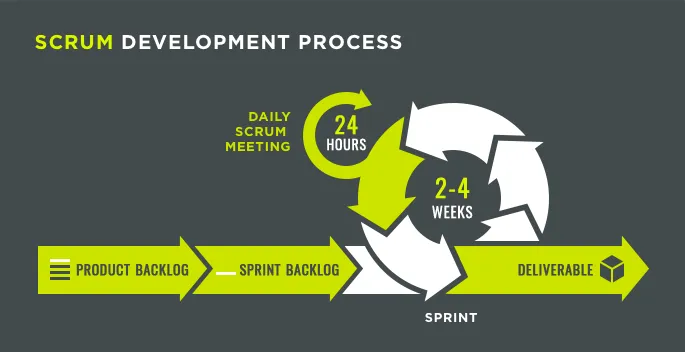What's the chance your software development project is delivered on time and to the requirements you need?
Software developing as any other work practise has its own methodologies and models. Now we’ll discuss Scrum, a special framework for creating software products in close contact with you. If you know the professional details required for the software development process you would understand why a development team act the way they do.
Suppose you thought of an excellent software solution which could help you in business and even found developers who are ready to implement your dreams in a high-quality bespoke software. What’s next? Always the first step is to describe your ideas and visions and the development team (good one) will ask you many questions about the product you have in your mind. When you are starting to put everything on paper all of a sudden you begin to realise that your desired software is much more complicated and unclear. Yet that was always the way it seemed from the beginning. It appears to be like a big blue ocean: endless, deep, unknown and there are numerous ways to go and uncountable things to check and try. In situations like this a project manager usually suggests to use a Scrum approach to development.
Not in rugby but in programming
As with a lot of professional programmer’s terms the name Scrum will no doubt confuse you but actually it’s one of the most popular agile frameworks which helps to manage software development. It was named after the rugby technique that involves players packing together in an attempt to gain possession of the ball. As for programming Scrum is one of the project manager’s working tools. Nowadays it becomes one of a best practises being used worldwide for any product development type: from games to bank and medicine software. If you take into account statistics you understand why it is so popular. The Scrum development approach results in a product that is 3,5 times more successful than projects with classic methodologies.
So, Scrum’s main features and requirements as a development methodology are:
- Adaptability to your own issues
- Opportunity of implementing any changes during the course of a project
- The full engagement and involvement in every stage of the development process
- Features are being developed according business and end users needs
- Each iteration, in Scrum it is called Sprint, a ready-product is being delivered, which can be checked, tested and even released to production.
The professional language that is the Scrum framework is the popular model Agile. This flexible strategy entails the use of different kinds of methods depending on particular goals and tasks.
How does Scrum work?
The working principles of this framework are similar to time-management. As a rule, one team completely runs the one project. There are defined roles for each member of the team and at the same time the whole team have to be cross-functional (to meet the challenges together) and self-organising (to correct tasks for itself, act with the situation and finally to present a working product). All the team is responsible for any failures, not just one person, mitigating the risks and potential pitfalls.
According to Scrum technology, developers work in close cooperation with the project manager and with you as the customer. The workflow is separated into several so-called iterations or sprints: short periods of time (usually they last from 2 to 4 weeks). The global objectives also fall into smaller tasks and sprint planning is composed of concrete goals and tasks for each period.

Transparency is a must: you are a full-fledged member of the software developing team
In Scrum as a customer you are not cut out waiting for the developers team to bring a final product. Moreover you are dedicated as a product owner to be a part of the team and define what’s the next best and essential features for business needs that should be implemented.
A core principle of working with the Scrum strategy is direct and constant communication between the development team and the client to allow information sharing, and testing intermediate versions of the software. So, you get the opportunity to actively participate in the development process, see the project at various stages and control the implementation of the tasks after each elapsed sprint. As a result there is a clear vision for the progress synchronised with each team member which leads to less effort and more closer to the real end-product required that will be used by end-users.
It is all about working software: end-result should be achieved each sprint
Each sprint is a working version of the final product which developers have to present in accordance with the plan. In Scrum it is called Sprint Increment with a sense that each iteration should add business value to the software not just some feature that might not be required or not be used by end-users. To compare the product in a classical approach can be seen only somewhere near the end of the project. So in Scrum the team works in such cyclic rhythm until the project’s end. That’s why it is easy to make adjustments at any time during the workflow, you can change and move the position of issues depending on its relevance at the time and conditions.
Even the concept of a final product can be redefined and changed completely during sprint to sprint if it makes sense.
Waterfall vs Scrum
Of course such a simple and effective methodology has some constraints. It can’t be used for any projects and any team. For example, it’s very important if every member of the development team is a professional and is motivated on the result as a working product and is focused on your needs. Also it requires more time for manual and autotesting than in other approaches but with the benefit of a stable product with each Sprint.
As for the projects, the flexible methods relating to the Agile family are usually not suitable for large, very lengthy and expensive projects which last for 3-5 years with 50-100 team members that have lots of bonds and hierarchy, responsibility and expertise separation where a coherent plan, and rigorous documentation are vital. That’s why the development strategy has to be changed and the software is built using other principles. The classical approaches are preferable in these cases. Such as the famous development model Waterfall. This framework is well structured and it works when all the requirements, features and technologies are known in advance. You can find out more about this strategy here.
Experienced software development company which is creating software and apps chooses the best methodology for the project depending on your requirements.
A well-planned Waterfall or adaptive and flexible Scrum development will enhance your project when you are working with a professional software development team.
Senior Project Manager
With a dash of strategy and a sprinkle of agility, Ekaterina ensures projects dance to the rhythm of deadlines while leaving clients with a standing ovation.
Subscribe to our Magora
Newsletter:








